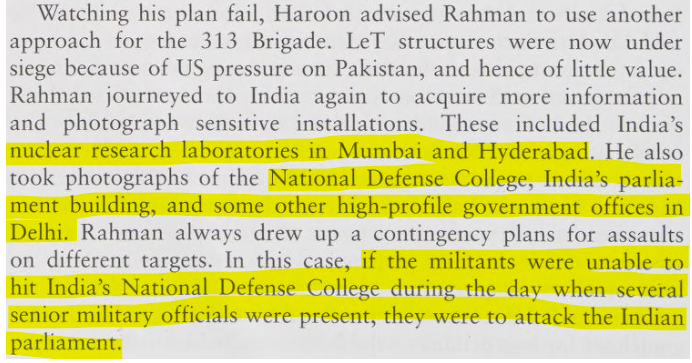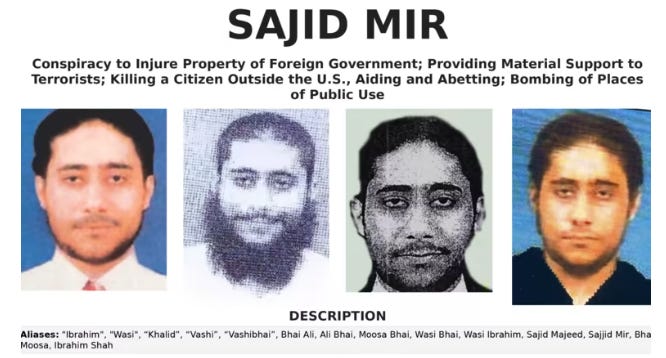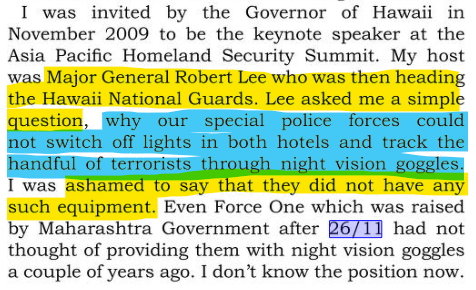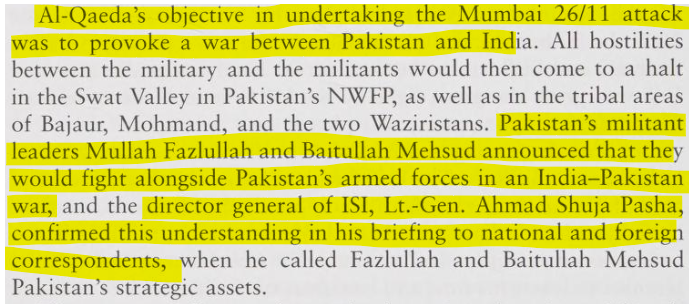The Real Story Behind the Attacks of 26/11 #367
Mumbai 26/11 was an Act of war not just of terror. Pakistan's establishment sent commandos to hit India. But the outcome of those events turned the tide against Pakistan forever. The story is riveting and worth reading!
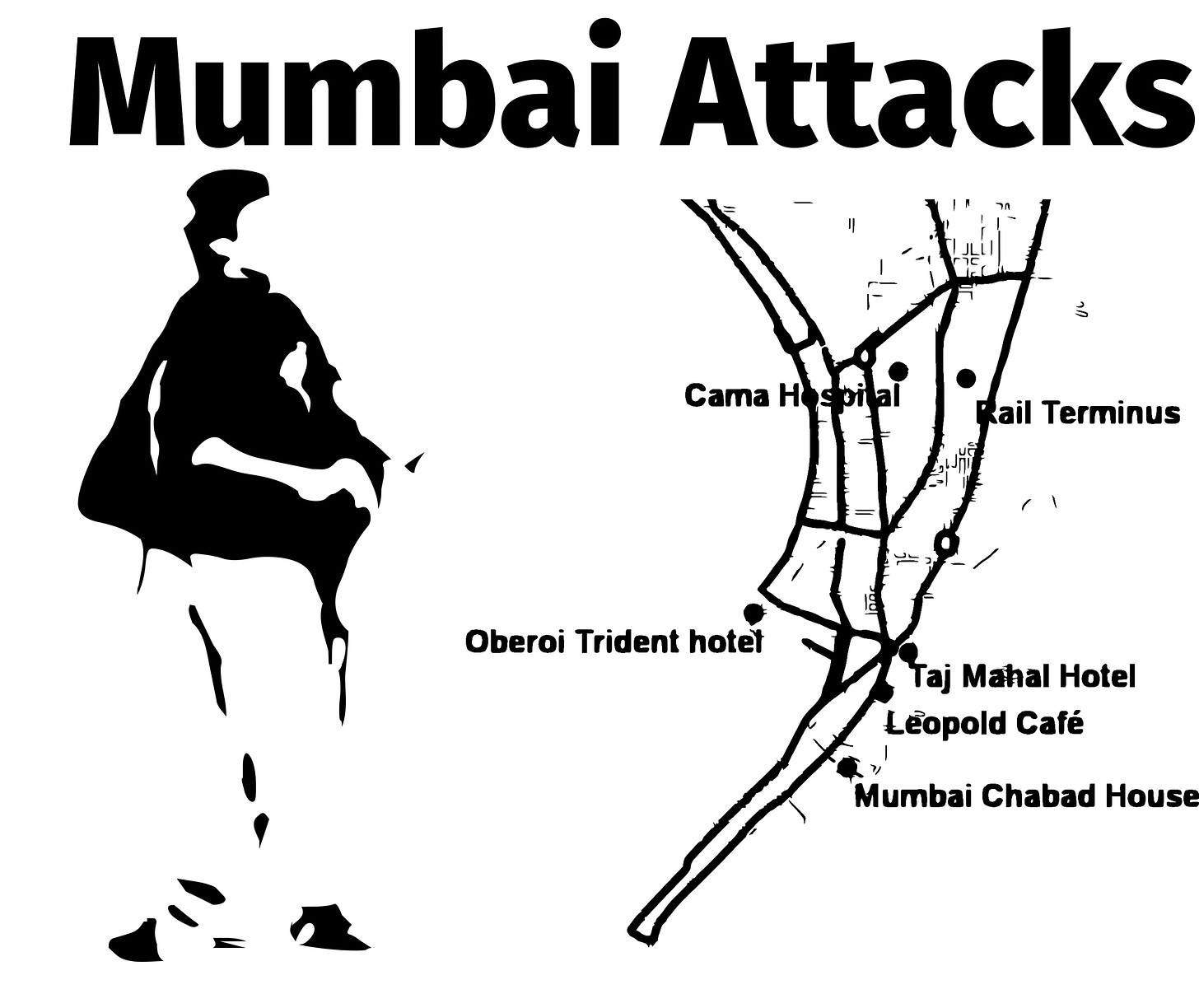
“the flames are silent,
Peace is violent,
Tears are frozen
’cause massacre was chosen.
~~ 26/11– Mumbai terror attack memories” ― Ankita Singhal
Even in the darkest of days and events, something mysteriously useful emerges. If one has patience.
What was one of the worst ever attacks on India - not a terror attack but an attack by the commandos trained by Pakistan on the largest city of India became the basis of a new beginning.
A reset.
As the bags of the 10 Jihadi terrorists trained in commando style announced, their actions really did change the tide.
Out of that came the expose of the internal villains and traitors and their sinister plans. And the network of terrorists who were working from outside and their Modus Operandi.
The story of these attacks is worth digging into.
At 8 pm on November 26th, 10 men with Chinese rucksacks, 10 AK-47s, 10 pistols, Ammunition, grenades, explosives, timers, maps, water, almonds, and raisins were making their way into Mumbai.
The logo on their backpacks said "Changing the Tide".
Which they would. In the most sinister way.
Their instructors had given them a mantra for their operations.
"Surprise will get you in and fear will scatter the police."
Their journey started on November 22nd from Karachi. On the 23rd, they hijacked an Indian trawler named Kuber. It was owned by Hiralal Masani. (Source: Hindustan Times)
They forced the captain of the captured trawler to navigate 309 nautical miles to Mumbai. It took two days for Kuber to make its way to the port area. They called their handlers who told them to kill the captain of the boat. So while others held him, Ajmal Kasab slit his throat. They left him in blood there and jumped into the yellow dinghy and made their way to their landing spot.
They reached dry land at 8.20 pm.
The fishermen's area was kind of deserted. People were busy watching the India-England 5th ODI in Cuttack. Sehwag almost scored a century and Tendulkar, Dhoni and Suresh Raina ensured a 6-wicket victory scoring half-centuries. (Source)
That match may have saved many lives in that village itself.
As Bharat Tandel, a local resident, challenged them they brushed him aside and moved on.
Bharat Tandel was on the dockside at the Koliwada fishermen's colony in south Mumbai when he saw the rubber dinghy that would bring carnage to the city motoring towards the shore. "I thought it was strange when I saw them get off the boat and noticed that they were carrying rucksacks," said the bare-foot fisherman. "I asked them what they were doing here and they told me to mind my own business." (Source: 'I thought it was strange...' / News24)
And then started a mayhem that engulfed Mumbai.
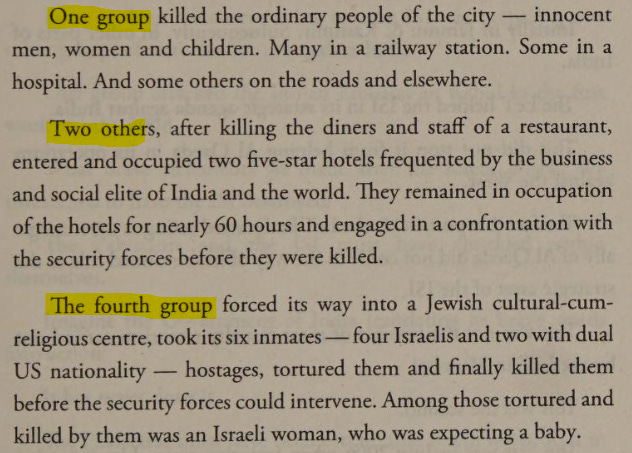
Here are the details of the areas and a map of Mumbai where the attacks happened.
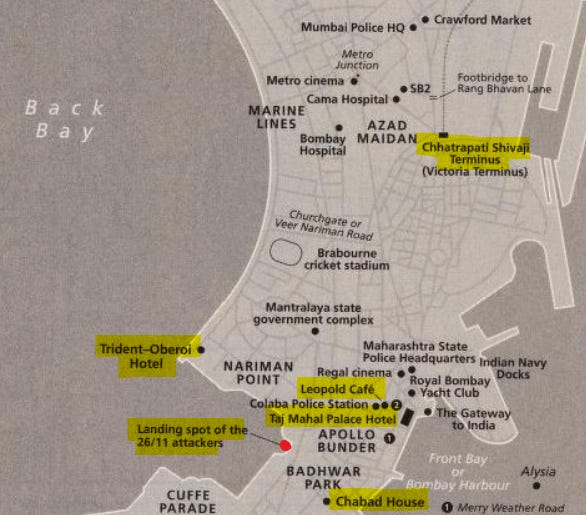
Chhatrapati Shivaji Terminus railway station: (November 26) - In a mere 90 minutes attack, 58 people were gunned down. While leaving the train station the LeT jihadis fired at the crowd gathered near the police barricade. 10 people died there.
Cafe Leopold: (November 26) - The LeT jihadis entered the cafe and gunned down 10 people within 15 minutes
Cama and Albless Hospital: (November 26) - The LeT jihadis shot at a group of police officers and killed six of them. After the attack on the CST railway station, Kasab and his fellow terrorist Ismail Khan targeted the Cama Hospital. They came in via the back door but the hospital staff locked all doors. They then ambushed the police team outside the hospital and killed 6 of them including Hemant Karkare. They then hijacked their jeep in which they went about spraying bullets indiscriminately.
Nariman House: (November 26-28) - This was an attack on Jewish Community Center. Seven people were killed in three days
Oberoi-Trident Hotel: (November 26-28) - Three-day siege of this hotel left 30 people killed. Two terrorists, Abdul Rehman alias Abdul Rehman Chhota and Fahadullah alias Abu Fahad, entered the hotel through the restaurant and fired on the crowd and then took 143 people hostage
Taj Mahal Palace and Tower Hotel: (November 26-29) - This hotel saw the worst attack and in a four-day siege left behind a killing field with 31 people dead.
Ajmal Kasab and Ismail Khan - who were in the jeep that was taken from the policemen after killing the six including Karkare - were intercepted near Girgaum Chowpatty. That is where police constable Tukaram Omble grabbed the barrel of their rifle and the police captured him.
9-11 was probably the biggest attack against any country by a group of people propelled by a religious ideology. A group of Islamists members of and trained, funded and supported by Al Qaeda - an Islamist terrorist organization - attacked US soil.
Even though there is evidence that Pakistan supported their endeavor (Who REALLY carried out the 9-11 attacks?), it is also true that Al Qaeda as an organization was pan-Islamic and went beyond any one state or nation.
It was truly an attack by one set of religionists against a country. It was not an attack by a state against another state.
The attack on Mumbai, India on November 26th, 2008 was very different. The attackers were members of Lashkar-e-Tayyaba (LeT) an Islamist terror organization trained by Pakistan. Pakistan's establishment was directly involved in the attacks.
The cell phones used by the Pakistani officers to talk to the Jihadis and give them instructions were their personal phones and there was no concern of being intercepted and being found out.
There was a swagger and cocky mindset that planned, executed, and managed the attacks.
From the Pakistani side, it showed their ascendance and supremacy when it came to attacking India at will at the scale it desired.
From the LeT side, it showed that they wanted to announce to the world, and more so internally to the Islamist terror organizations network, that they were the “new kid on the block” who were taking a leading position.
It was as much a play by LeT against the leadership of Al Qaeda as it was an attack on India.
Sinister Double Speak
In the days after the Mumbai attacks, the US started talking (and working) with Pakistan and India as Secretary of State Condoleezza Rice met with the Indian side and Adm. Mike Mullen, the chairman of the Joint Chiefs of Staff, met with the Pakistani side in Islamabad.
New York Times reported on these meetings in the usual "forked-tongued" way. Check the two parts which are in bold to see the hypocrisy. On one side the link between former officers of the Pakistan Army and the ISI trained the terrorists, and on the other that there was no link with the government. Not bringing up there was little difference between the ex and active members of the ISI. For that, we will have to go into another book by a Pakistani journalist who was killed for writing what he did.
A former Defense Department official said Wednesday that American intelligence agencies had determined that former officers from Pakistan’s Army and its powerful Inter-Services Intelligence agency helped train the Mumbai attackers. But the official, who spoke on condition of anonymity, said that no specific links had been uncovered yet between the terrorists and the Pakistani government. (Source: "Ex-U.S. Official Cites Pakistani Training for India Attackers"/New York Times)
Here Hamid Gul, the ex-ISI chief discusses the Mumbai attacks on Fareed Zakaria on CNN. Specifically, watch from 1.25. He talks about the "Hindu militants" and specifically about Lt Col. Purohit. We will discuss Hamid Gul's later in this article. So please keep his discussion with Fareed in mind for the whole context and his sinister personality.
Gul keeps denying the charge of ISI's involvement in the Mumbai attacks masterfully and keeps calling it "an inside job" because of the arrest of Lt Col Purohit.
Get a Weekly Insightful Newsletter: If you are here via a search or because someone shared this newsletter with you, please do subscribe to some insightful content that is published every Sunday morning US time and evening India time.
The Conspiracies and the diversion
During a court appearance on May 21st, 2009 at Justice M.L. Tahaliyani's court in Mumbai's Arthur Road prison, Ajmal Kasab mentioned the name Abu Jundal.
No one had heard of him. So no one noticed.
3 years later in June 2012, Saudi Arabia deported a wanted Lashkar-e-Toiba (LeT) operative, Syed Zabiuddin Ansari. His other alias was Abu Jundal. He had been involved in a blast at Pune's German Bakery in February 2010.
One of his plans was to create enough false information so the fingers could be pointed at Indians and falsely implicate Hindus to create the "inside job" theory of Hamid Gul.
In fact, while the attacks were ongoing, Zaid Hamid appeared on Pakistan TV to share this "information" in order to create the "Hindu Terror" theory. He even had a name for Ajmal Kasab. Amar Singh. And he also points at the Kalava or the red thread around Kasab's hand.
The Indian ecosystem did not let Abu Jundal, Hamid Gul, or Zaid Hamid down. From the former Maharashtra Chief Minister AR Antulay to Urdu press to Congress General Secretary Digvijay Singh to Mahesh Bhatt - everyone became the mouthpiece of the strategy that Abu Jundal, whom no one in the Indian intelligence set up knew by then, had hatched!
"There is more to it than meets the eye," former Maharashtra chief minister Abdul Rehman Antulay said outside the Lok Sabha on December 18, 2008, about the death of Maharashtra Anti-Terrorism Squad chief Hemant Karkare. Karkare, Additional Commissioner Ashok Kamte and Inspector Vijay Salaskar had been ambushed and killed by Ajmal Kasab and his accomplice Ismail Khan on November 26, 2008. Karkare was probing the Malegaon blasts, which had resulted in the arrests of Hindu fringe elements such as Lt-Col Shrikant Prasad Purohit, Sadhvi Pragya Thakur and Swami Aseemanand. Much of the Urdu press in India placed the blame for the attack on a diabolical Zionist-RSS nexus. Aziz Burney, group editor of leading Urdu newspaperRoznama Rashtriya Saharablamed Hindu extremists. 'Is there any connection between the 26/11 attack and the Malegaon terror attack?' screamed a headline in the daily on November 29. 'This is a joint terror operation by Sangh Parivar and Mossad' said theUrdu Timesof November 30, 2008. On December 5, Roznama Rashtriya Sahararan another story: 'Who do you believe, Kasab the terrorist, or Karkare the martyr?' The paper hinted that the 26/11 attack was the work of Hindu fundamentalists and an elaborate plot to silence Karkare. 'Hindu terrorists are behind Mumbai attacks' said the Akhbare Mashriq on December 6, 2008. In September 2009, a retired Maharashtra inspector-general of police, S.M. Mushrif, in his bookWho Killed Karkare?, blamed the Intelligence Bureau and Hindu extremists for 26/11. The conspiracy theory was also enthusiastically bought by politicians who wanted to mine the Muslim vote. On December 6, 2010, senior Congress leader and former Madhya Pradesh chief minister Digvijaya Singh released Burney's book26/11-RSS ki Saazish, which accused the RSS of planning and executing the 26/11 attack. Five days later, Singh claimed that Karkare had rung him up hours before he was gunned down and complained about threats and pressure from radical Hindu groups. (Source: "Jundal's arrest exposes Pak's agenda of turning 26/11 into an Indian conspiracy" / India Today)
Not just them but even the former Inspector General of Police, Maharashtra, SM Mushrif joined in. He in fact said in his book "26/11 Probe - Why Judiciary Also Failed?" - that Ajmal Kasab was someone that the Crime Branch had planted "from its stock". His injuries and his confessions were also fake per this ex-IG of Maharashtra Police.
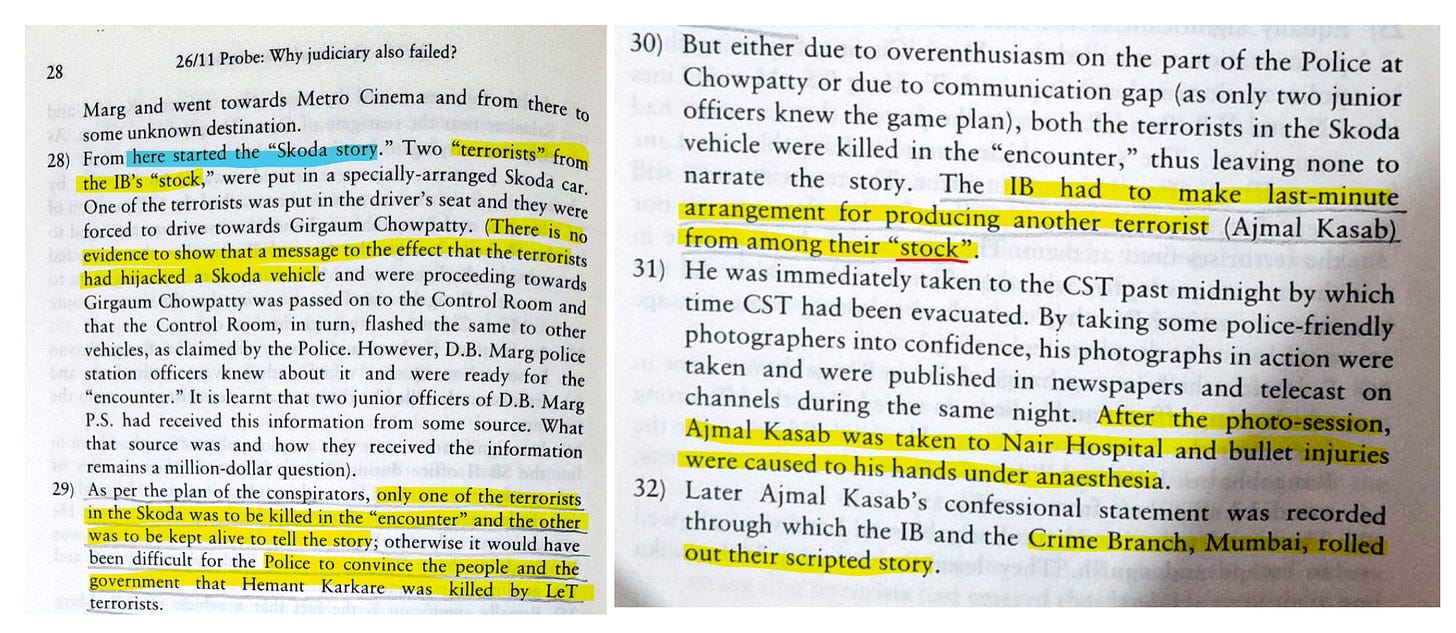
Jundal or Ansari had it all planned along with the LeT to facilitate just that! From teaching them Hindi to assigning them Hindu names (Ajmal Kasab was btw assigned the name, Sameer Choudhary). That red thread or kalava that Zaid Hamid pointed out while the attack was ongoing - was actually bought from the Siddhivinayak temple by David Headley
Ansari's confessions have further unravelled the secret Pakistani plot. He told interrogators of his role in teaching the 26/11 attackers Hindi. He would give them Hindi magazines and conduct conversations with them to sharpen their language skills before they left Karachi. He taught the attackers to blend into India-greet people with a proper 'namaste', maintain a low profile and be polite to women. There were other aspects to this smokescreen-the terrorists were made to wear sacred red threads bought for Rs 20 each by LeT scout David Coleman Headley from Mumbai's Siddhivinayak temple. All 10 terrorists carried fake identity cards of Arunodaya College, located in Hyderabad. They also took Hindu names. Ajmal Kasab became Sameer Choudhary and Ismail Khan was Naraish Verma. An LeT operative pretended to be 'Kharak Singh from India' and purchased Internet calling services from a US-based firm for $250 (Rs 10,000). The terrorists were told to communicate with their Karachi-based handlers using phones with Indian SIM cards. (Source: "Jundal's arrest exposes Pak's agenda of turning 26/11 into an Indian conspiracy" / India Today)
After Abu Jundal was arrested, the truth was out in the open. Pakistan was rattled and their "friends" amongst the Indian politicians, Police chiefs and the 'journalists' backtracked their original conspiracies.
Now that the conspiracy has been exposed, some of its original theorists have backtracked. Digvijaya Singh says he had already clarified about his post-26/11 comments. "There is nothing more to say. I am happy that Home Minister P. Chidambaram has upped the ante on the terror issue and has pressed Pakistan to admit facts relating to Jundal having trained terrorists who attacked Mumbai," he told India Today. Antulay called his November 27 statement "a genuine mistake". "Multiple theories were floating in the aftermath of the attack, especially the one revolving around the death of Karkare," he said. Antulay admitted, however, that the Hindu terror angle had momentarily deflected the nation's attention from the LeT. Mushrif now refuses to comment because the 26/11 case is subjudice but says he never questioned Pakistan's role in the attack. "If someone wants to comment on this issue he should approach the court and seek a reinvestigation," he said. Burney's newspaper ran a front-page apology on January 29, 2010. Burney himself is, however, unapologetic and says many questions on 26/11 remain unanswered. Film producer-director Mahesh Bhatt says there is no denying Pakistan's involvement but refuses to believe the theories being floated by Indian investigators now and calls for a debate. "After the 9/11 attack, people in the US raised questions on the identity of the attackers. Nobody was apologetic about their views," he says. (Source: "Jundal's arrest exposes Pak's agenda of turning 26/11 into an Indian conspiracy" / India Today)
They all had been discredited of course, but the larger conspiracy linked together by the stances taken by the different actors and the template that they used showed the folks who could have been behind the Mumbai Attacks.
What about Lt Col. Purohit?
Interesting because Lt Col Purohit was arrested on November 4th, 2008 (Source: HT). Just about 20 days before the Mumbai attack! For more details on what the Mumbai attacks really were and the link between Lt Col. Purohit and the Mumbai Attacks (26/11), please read our earlier post.
Insightful newsletter of Drishtikone: Issue #328 - 26/11 was an Act of War, not a Terror Attack
Also, listen to this podcast with Col. Hunny Bakshi on Lt Col. Purohit.
There was no real case against Lt Col. Purohit.
The Terrible 2008, Warnings and Clueless Intelligence Agencies
We remember 26/11 from 2008, but there were Other major acts of terrorism (outside of J&K) on Indian territory that year.
Four in Jaipur (May) - a series of nine synchronized bomb blasts took place on 13 May 2008 within a span of fifteen minutes. 80 dead with 216 or more people injured (Source: Indian Express)
Bangalore (July) - a series of nine bombs exploded leaving 3 persons dead and 20 injured (Source: Rediff)
Ahmedabad (July) - series of 21 bomb blasts on 26 July 2008, within a span of 70 minutes left Fifty-six dead and over 200 people injured. (Source: IDSA)
Delhi (September) - series of 5 bomb blasts within a span of few minutes on 13 September 2008 left 20 people killed and over 90 injured. (Source: Times of India)
The terror climate against India was at its peak in 2008. Major bombings like the ones listed above and lots of warnings of an impending attack were coming as well.
There were already intelligence warnings that the terrorists wanted to kill Israelis in Goa. Khalid Sheikh Mohammad had already shared that Al Qaeda wanted to attack the Israeli Embassy in New Delhi. But the reason why the Pakistani Jihadis chose Nariman House and not the Israeli Embassy in Mumbai is that at that time of the night (when they landed from the sea), there would have been no one in the embassy. The Nariman House would, however, have residents.
But what was even more intriguing was that the existence of this Jewish center was not known much outside the Jewish circles. That the terrorists had identified and targeted this showed the level of planning that had gone into this attack.
It is just a coincidence that the attacks happened on the 26th. Had they happened a couple of days later the disaster could have been even worse. So, here is the extent of the intelligence failure.
Maharastra Home Minister said in the legislative assembly on December 20th, 2008 that the Intelligence Bureau (IB) had sent the advisory on November 19th to the Navy and the Coast Guards regarding an attack by LeT. They did not however share it with the Maharashtra government.
Worse, the then PM Manmohan Singh was scheduled to come to Mumbai on November 28th and the IB and RAW officers had visited the Oberoi-Trident Hotel on November 23rd. After a "proper review" they cleared the hotel for the PM's visit.
It was apparently on November 26th, when PM's Special Protection Group (SPG) visited the Oberoi-Trident hotel to conduct the "Advance Security Liaison" (ASL) just before terrorists struck. They could not even complete their report! (Source: Defence and Security Alert 2016 08).
Just let the enormity of the entire Intelligence Agency Network's failure sink in!
The Major Players from Pakistan and the archaic Indian side
So who were the main players involved really?
In a dossier released by the Indian government in January 2009, two Pakistani Army officers - Major General Saab and Colonel R Saadat Ullah - were charged as well.
Who was this "Major General"? The US intelligence officers believed it was former ISI Chief Hamid Gul.
A senior US military intelligence official familiar with the dossier said that the “Major General” is indeed Hamid Gul, the retired former chief of the ISI. “It’s Gul,” the official told The Long War Journal. “This is why the US is trying to get him on the UN list of terrorists.” In December 2008 the US attempted to get Hamid Gul and other former military and intelligence officials added to the UN list of designated terrorists but has so far been rebuffed. (Source: Mumbai handlers in Pakistan cheer after ordering murders over phone / Long War Journal)
Now go back to Gul's discussion with Fareed Zakaria and see how the ISI and their serving and former officers play the entire global media.
Major Abdul Rahman and Major Haroon were the other main strategists of the Mumbai Attacks.
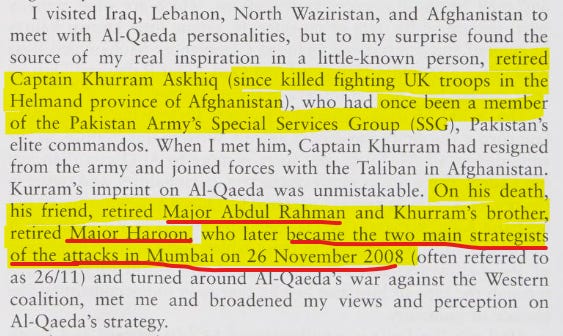
Major Abdul Rahman was an ex-Pak Army officer who moved to LeT upon retirement in 2007. He worked closely with Lashkar-e-Taiba and coordinated with David Headley. Rahman along with David Headley was also instrumental in planning the attack on the Danish newspaper Jyllands Posten.
The plans were ready to do more devastating attacks on Indian soil. Specifically the National Defense College. The strategies and the plans of Major Haroon and the 313 Brigade were ousted by a Pakistani journalist.
When Syed Saleem Shahzad, the Asia Times journalist, had asked Illyas Kashmiri about his plans, Kashmiri had told him that they were planning to give India a much bigger jolt than the Mumbai attack.
"So should the world expect more Mumbai-like attacks," I asked. That was nothing compared to what we have planned for the future," he replied.
What is interesting is that the book "Inside Al-Qaeda and the Taliban: Beyond 9/11" by Saleem became the reason - along with his other reporting - for his being killed by the ISI. (Source: "The Journalist And the Spies" / The New Yorker)
Sajid Mir and David Headley
Sajid Mir was Lashkar's head of international operations and surveyed targets in India as a cricket fan.
He was David Headley's handler as well.
The court filing also said that the U.S. government thinks a Lashkar-e-Taiba operative who “coordinated the attacks” in Mumbai was Headley’s handler. The government also thinks the operative is one of the people who can be heard on intercepts giving real-time guidance to the 10 Lashkar-e-Taiba gunmen on how to continue their three-day assault. In court documents, the Justice Department has identified the operative as “LeT Member A,” but U.S. and Pakistani officials think he goes by the name Sajid Mir, and that he is Lashkar-e-Taiba’s head of international operations -- or attacks outside of Pakistan. One senior Pakistani official said Pakistani authorities were still trying to determine Mir’s identity, and that they think he was a ranking member of the Pakistani army until several years ago. (Source: "Chicago terrorism case widens / LA Times)
Headley had created the list of the potential sites in India and also the way to enter India - via a boat in Mumbai harbor.
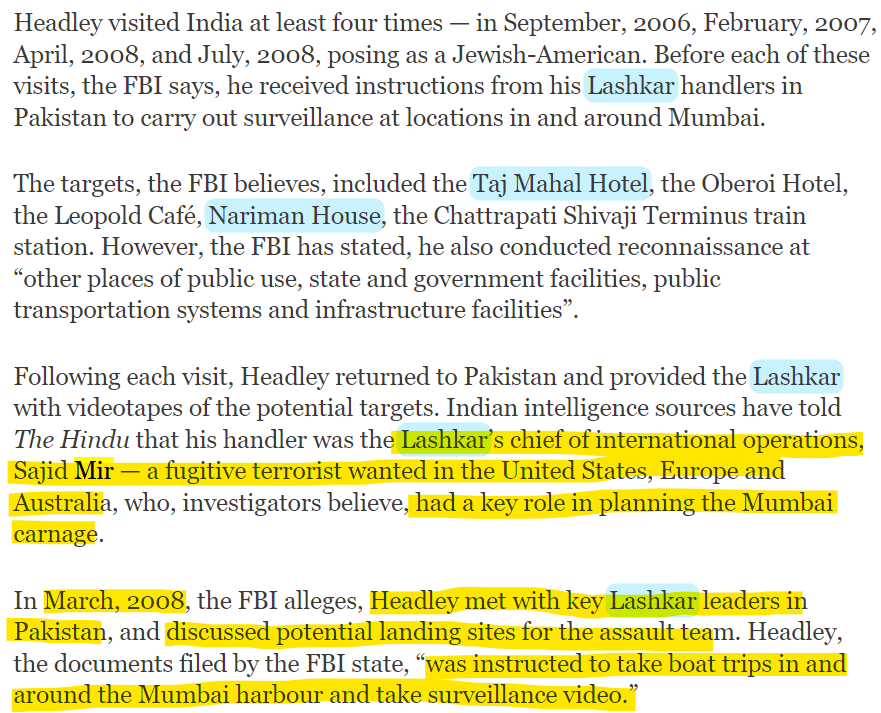
The Pakistani terrorists and Army were working with the most sophisticated weaponry and gadgets (Satellite phones with GPS and masking networks). The Indian side, however, was working with archaic and rudimentary equipment.
While the attack was going on for three and four days in Oberoi/Trident and Taj Mahal, the special forces would have resorted to many tactics to neutralize the terrorists. For example night vision goggles.
The Indian side was just not prepared. Or they were not allowed to be ready at all.
The objective/s behind Mumbai Attacks
Yes, the Pakistani Army and the Jihadis hate Hindus in specific and Indians in general. But what did they plan to accomplish through these attacks?
The manner, the targets and the coverage showed that there were multiple streams of goals they had hoped to achieve.
Disrupt the Indo-Pakistan peace process
Destroy Indo-Israel close relationship
Discredit the Indian counter-terrorism community, intelligence agencies, and policy establishment
And, one can say that it was a brilliant move if the promotion of the "Hindu Terror" narrative is thrown in as well.

There was another element to these attacks as well. A continuation of the disruption of Indo--Pak peace process.
Per another account, Al Qaeda and LeT's goals for the Mumbai attacks were to provoke an Indian-Pakistan war. In such an eventuality, these two would fight alongside the Pakistani Army.
One of the biggest failures post-Mumbai attacks was to not draw enough attention to the larger picture of what Pakistan set out to do - attack Israel and the Jewish as well as an attack on nationals and businessmen of other countries. This was important for a change in policies of the West, specifically the US, with regard to Pakistan and more importantly terrorist groups like LeT coming from Pakistan.
Mumbai Attacks were a failure on every front - policy, political, intelligence, social, law enforcement, judiciary, and the media.
RAW RESEARCH
Here are the documentation and links that I saved as part of my research for an article. Many of these links I may have shared in my article and many I would have used in understanding the topics at hand. Beyond this newsletter, I tend to collate all my research even in the future into these sub-pages. So bookmark them for future reference. Please feel free to dive in and use it for your own analysis.
Notion – The all-in-one workspace for your notes, tasks, wikis, and databases.
Video Corner: India in the Global Geopolitics
Here is an important discussion that Dr. Jaishankar, India's Foreign Minister had at the Times Now Summit 2022. He speaks on India, China, and global geopolitics.
He discusses India's role in the Ukraine crisis and the need to have an independent view of the world and the events, as opposed to being a rubber stamp country that India, despite its size and importance, has been.
A very insightful discussion.
If you like our content and value the work that we are doing, please do consider contributing to our expenses. CHOOSE THE USD EQUIVALENT AMOUNT you are comfortable with.
If you like this post - please share it with someone who will appreciate the information shared in this edition.
Today’s ONLINE PAPER: Check out today’s “The Drishtikone Daily” edition. - THE DRISHTIKONE DAILY





